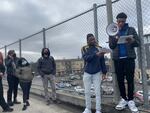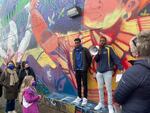
Aki Franklin reading his poem "Picture Me Thriving" on the In Our Shoes walking tour of Lents in Southeast Portland on Feb. 5, 2022.
John Notarianni / OPB
On a cloudy Saturday in Portland, Aki Franklin stands on a pedestrian bridge in Lents, the east Portland neighborhood where he lives. The 17-year-old David Douglas high school student has a megaphone in his hand.
“I chose this location because it gives me a sense of higher ground, overlooking the city,” Franklin says. “This is my vision.”
As he faces a crowd of nearly 40 people, Franklin begins to read a poem he wrote.
“Picture me growing like no other, dreaming of big things. I have a path, I hope the road can handle me.”
Aki Franklin reading his poem “Picture Me Thriving” in Lents, Portland on Feb. 5, 2022.
This is the inaugural event of the In My Shoes project. Each weekend in February, young Black men are leading tours across Portland and Vancouver, inviting the community to get to know them and their neighborhoods.
Franklin and his co-tour guide, 19-year-old Ja’Mari Etherly, lead the group through the neighborhood, pointing out parks, schools, business developments and other spaces that are important to their lives. Etherly, who’s training to be a boxer, stops the group along a walking path.
“This trail is the trail I run every morning,” Etherly tells the crowd. “At 5 a.m., I’m up. Half the world’s asleep and I’m grinding. It also represents the highs and lows and my life: those mornings I don’t want to get up, I’m too tired and this and that, but in my head I’m like, ‘this is going to determine whether you’re a world champion or not, so you gotta get up, you gotta go, grind, grind, grind.’”
Expanding the narrative
In My Shoes was started by the local nonprofit Word is Bond, whose mission is to change the relationship between young Black men and law enforcement. Word is Bond founder Lakayana Drury says the idea came after watching the program’s participants do ride-alongs with the Portland Police Bureau. He saw a need for a reciprocal program, where the young men could tell their stories too.
“Black stories in Portland are not heard enough,” Drury says. “Black stories in the United States are not told enough, and often when they’re told, they’re not told by Black people, and they’re often very negative stories.”
Drury says those narratives flatten the complexity of people’s lives into inaccurate, clichéd narratives. “It’s not like everybody that lives in these communities or these areas is just a monolith of a story,” he says. “So we want to amplify the richness of stories that exist within the Black community.”

Ja'Mari Etherly speaking on the 'In Our Shoes' walking tour in Lents, Portland on Feb. 5, 2022.
John Notarianni / OPB
Aki Franklin, the tour guide leader, says Portland police officers were invited to come and experience the tours, so they could hear and see the community through their eyes. But on the morning when we met, very few officers had taken them up on the offer. For Franklin, it was a disappointment.
“My experiences with cops haven’t been the greatest,” he says, “but I don’t want to share those experiences, you know, because… I want to be the person to say, ‘Hey, I’ve had great experiences with cops, they helped my community.’”
“But where is that happening?,” Franklin asks. “On a normal day on patrol, they’re not saying, ‘Hey, how’s your day going?’ They’re just driving by on any typical day, or they’re driving by making assumptions… so it seems like, why am I the one that feels uncomfortable with them?”
Seeing both sides
Standing in Lents Park on Southeast 92nd Avenue, Etherly says that media narratives about his neighborhood tend to fall into one of two camps: either celebrating new business developments or sensationalizing it as a dangerous place.
“Most people only see one side of it,” he says, “the side that has a lot of businesses and stuff like that, but no one ever sees the other side of it. It’s kind of like, the other side, people choose to ignore because it has a lot of houseless people out here… but the houseless problem is getting worse and they just choose to ignore it.”
As we talk, young children are yelling and chasing each other, and teenagers play basketball 50 yards away.
“A lot of the things you hear about our neighborhood are just bad,” Etherly says. “Like, you know the shootings and everything going on. But kids are out here now, hooping, and it’s like, 30 degrees. There’s always something good going on in each neighborhood. It’s just, the only thing that gets seen as newsworthy is the bad stuff.”
For Etherly and Franklin, there’s at least three stories of their neighborhood. It has houselessness, violence and poverty. It’s also a place full of parks, gyms and recreational spaces where the youth can play and explore. And, like most Portland neighborhoods, it’s seeing a surge of new restaurants, storefronts and apartment buildings. Franklin says he sees those developments pricing out long-term residents out of the community.
“I’ve been living here since 2017,” he says, “and I’ve seen it go from just having houses to, oh, there’s these apartments that are like, $2,000 for rent. You know, for people that are slowly getting older, it’s hard to afford that.”
Etherly is quick with ideas to protect his community from gentrification, but he says it’s often hard to get adults to take his and other young Black men’s perspectives seriously.
“A lot of times,” he says, “decisions that affect our future are decided by people who are adults who, by the time it actually goes into effect, probably won’t be here anymore. A lot of times, the input of the kids is just not cared about, like we were not given the option to make decisions on anything.”
Defining community
Drury says he hopes the In My Shoes tours will give these young Black men a stronger sense of ownership of their own community. So far, the public is taking notice. All of this month’s upcoming events are already fully booked. Drury is pleasantly surprised by the demand.
“I didn’t know how much interest there would be, what kinds of people would show up,” he says. “I think it just speaks to the moment that we’re in.”
“Um, yeah, it’s a little bit overwhelming,” he adds.
But Drury is also deeply aware of the complex racial dynamics of Portland. Most of the attendees on the Lents tour were white, a pattern that he’s expecting to repeat in most of the nine events. He hopes the audience will have a crucial learning experience.
“People are trying to grapple with things like their whiteness,” he says, “trying to hear and seek out others’ stories, but you can’t just go up to a Black person, like, ‘tell me things,’ right? I think it’s an opportunity to learn, and to then take your privilege or your experience or whatever it is that you have and act on that.”
But that success is also leading to complicated conversations among the tours’ organizers. Drury says they’re asking each other questions about race, community, and what it all means.
“I asked them at one point,” Drury says, “do you want more Black people to show up on these tours, and for what reason?”
He says these conversations are good for the youth too, “because they’re able to then reflect on all of it and see it’s not just them, but it just generates so much larger conversations.”
Listen to Aki Franklin and Ja’Mari Etherly’s conversation with OPB Weekend Edition host John Notarianni using the audio player above.
